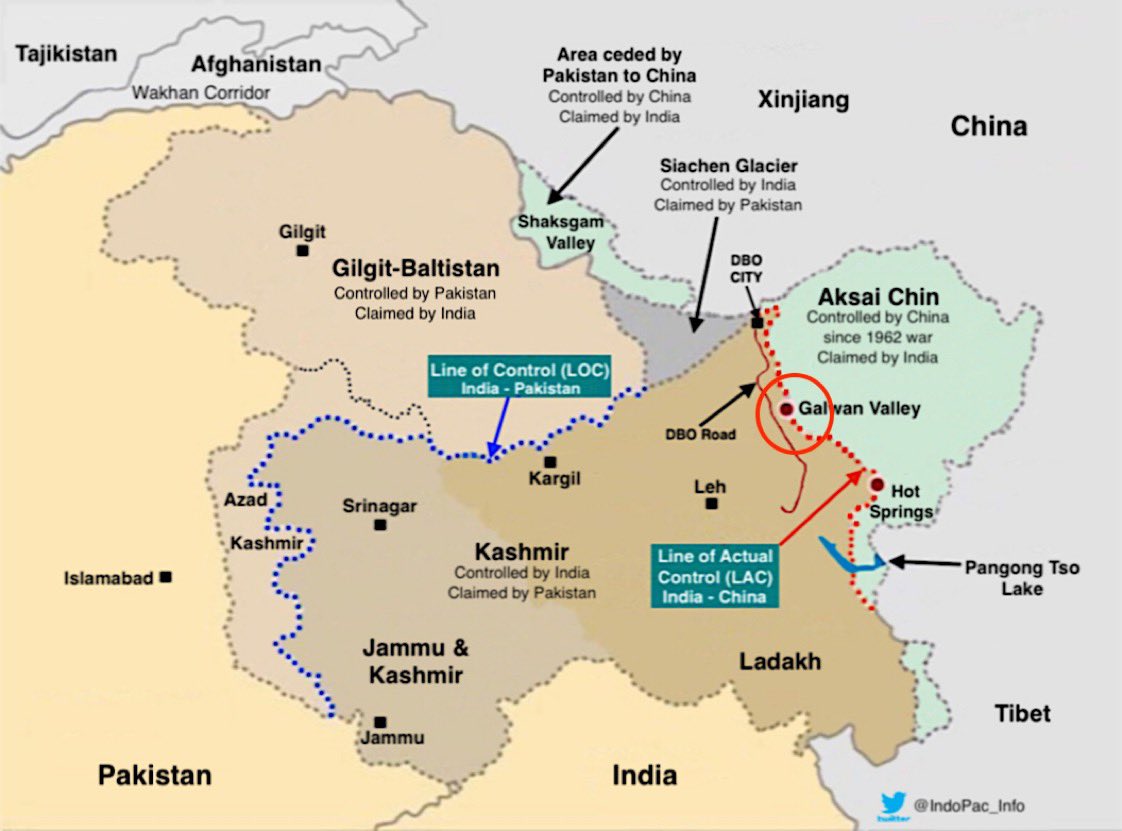Stabilise The Line Of Actual Control
Context:
The media frequently reports on violations and confrontations between Indian and Chinese forces along the LAC, even though both nations spend a significant amount of money on improving their military infrastructure and defensive readiness as they station personnel, supplies, and tools nearby.
Indo-China Relationship
- Historical Background:
-
-
- Cultural, economic, and diplomatic exchanges between India and China go back many centuries.
- However, boundary disputes and geopolitical rivalries have characterised the Indo-China relationship in the modern century.
-
- Border Disputes:
-
-
- The unsolved border dispute between India and China is the main source of animosity between the two countries. A 3,488-kilometer-long disputed border between the two nations is known as the Line of Actual Control (LAC).
- 1962 saw a brief but violent military war over the border that was won by China and gave them more territory in the Aksai Chin region.
- Since then, there have been several border clashes and standoffs between the two nations, most notably the ones in the Doklam standoff in 2017 and the Galwan Valley conflict in 2020, which left people dead on both sides.
-
- Trade and commercial Relations:
-
-
- India and China have strong commercial relations notwithstanding their border disputes. With billions of dollars in annual bilateral commerce, China is India’s largest trading partner.
- Trade imbalances and worries about Chinese products being dumped on the Indian market, however, have remained chronic problems.
- The Indian government has taken action to allay these worries, including placing tariffs and limitations on some imports from China.
-
- Geopolitical rivalries:
-
-
- As two of Asia’s key regional powers, India and China are increasingly competing with one another for influence.
- India is concerned about China’s ambitious Belt and Road Initiative (BRI) and its strategic investments in nearby nations since some of these initiatives are perceived as intruding on India’s area of influence.
- India has also taken issue with China’s close ties to Pakistan, particularly about its backing for Pakistan-occupied Kashmir.
-
- Diplomatic conversations:
-
- The two nations have participated in several diplomatic conversations and processes to resolve their differences and foster better relations, such as the meetings between the Special Representatives on the boundary issue.
- However, the border conflict has not been resolved quickly, and tensions between the two countries continue to flare up sometimes.
Need for stability
- Rising Tensions: The conflict in the Galwan Valley in 2020 caused India and China to experience rising tensions, which resulted in large military mobilisations and escalating rhetoric on both sides.
- Unstable and Dangerous Situation: Indicating the gravity of the situation, India’s External Affairs Minister remarked that the situation along the Line of Actual Control (LAC) in Eastern Ladakh continues to be highly unstable and dangerous.
- Potential for confrontation: There are worries that the current scenario, which is marked by heightened militarization and combative rhetoric, could turn into a major confrontation that would destabilise the area and have negative regional and global political and economic repercussions.
- Border problem complexity: Due to conflicting territory claims, the border issue between China and India is complicated. India rejects Chinese claims made regarding the entirety of Arunachal Pradesh and the occupied Aksai Chin. These assertions are extremely engrained in both countries’ narratives and are not likely to be readily changed.
- Concessions: Concessions are impossible for the current political regimes in China and India to make to promote a settlement of their border disputes that would be acceptable to both parties. Consequently, a long-term resolution to the border problem could not be possible shortly.
- Stabilisation in the short term: Due to the complexity of the situation, it is advised that both parties concentrate on actions that will stabilise the LAC and lessen the likelihood of war shortly. This strategy entails taking practical and efficient action to stop errors or unintentional escalations.
- Peaceful Accords: The 1993 and 1996 accords on upholding peace and tranquilly along the LAC are just two examples of existing agreements that both China and India should abide by. The region can become more stable if these agreements are respected and upheld.
Way forward
- Converting the LAC into a Line of Control (LC): It entails considering the LAC as a de facto border without regard for any potential border claims. This would lessen the need for troops to advance, but it might also bolster contested territorial claims. It would take maturity and collaboration on all sides for implementation to take place, yet settling on a border claim can be a difficult and delicate political matter.
- Restricted access to N entry zones: Allowing mutual patrolling or designating contested areas as no access zones: Designating disputed areas as no entry zones could prevent further escalation, but it could also consolidate opposing claims. Maintaining the status quo while allowing both parties to police these areas at mutually agreed-upon intervals may not resolve the underlying issues.
- Joint patrolling: Joint patrolling and more efforts to foster confidence Together, the parties can create more trust by jointly patrolling disputed regions and stepping up confidence-building initiatives. However, putting such measures into action would require a great deal of confidence and cooperation, which can be difficult when tensions are at their highest.
- Strengthening existing engagement mechanisms: Enhancing the efficiency of current engagement mechanisms, like the Border Personnel Meetings (BPM) and the Working Mechanism for Consultation and Coordination on India-China Border Affairs (WMCC), can offer forums for discussion and conflict resolution. To quickly address local concerns, it is crucial to make sure that these methods are supported by all sides and have enough authority.
Similar Topics
India And China On The Depsang Plains





